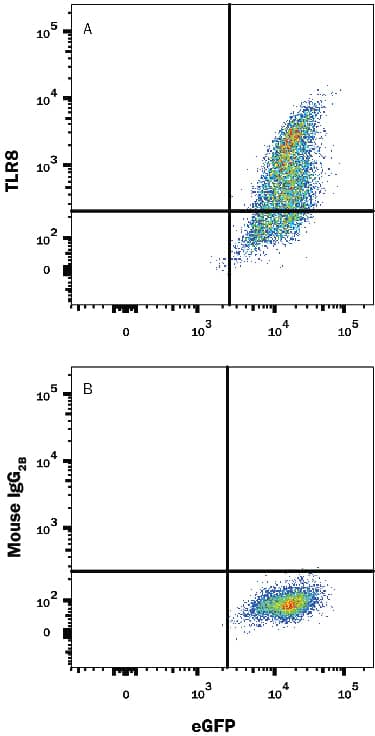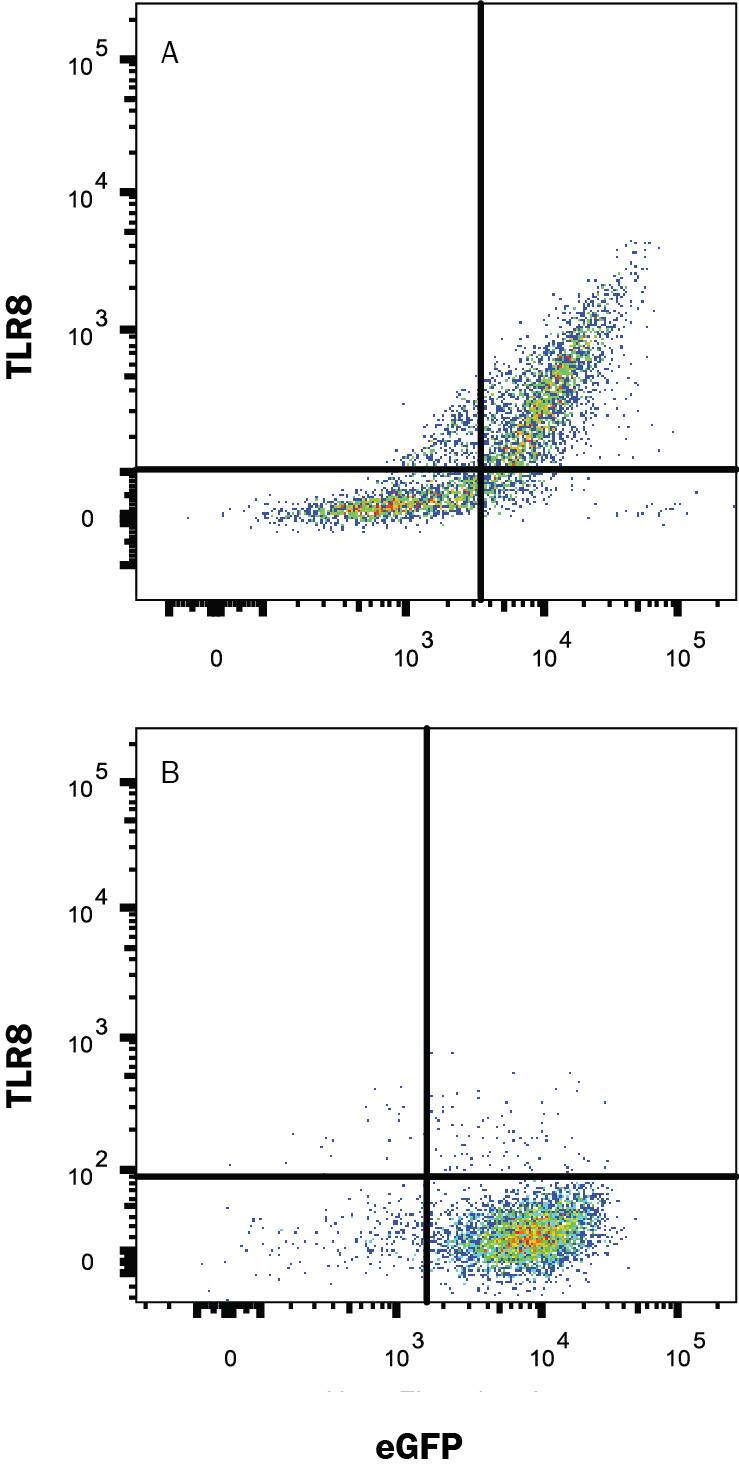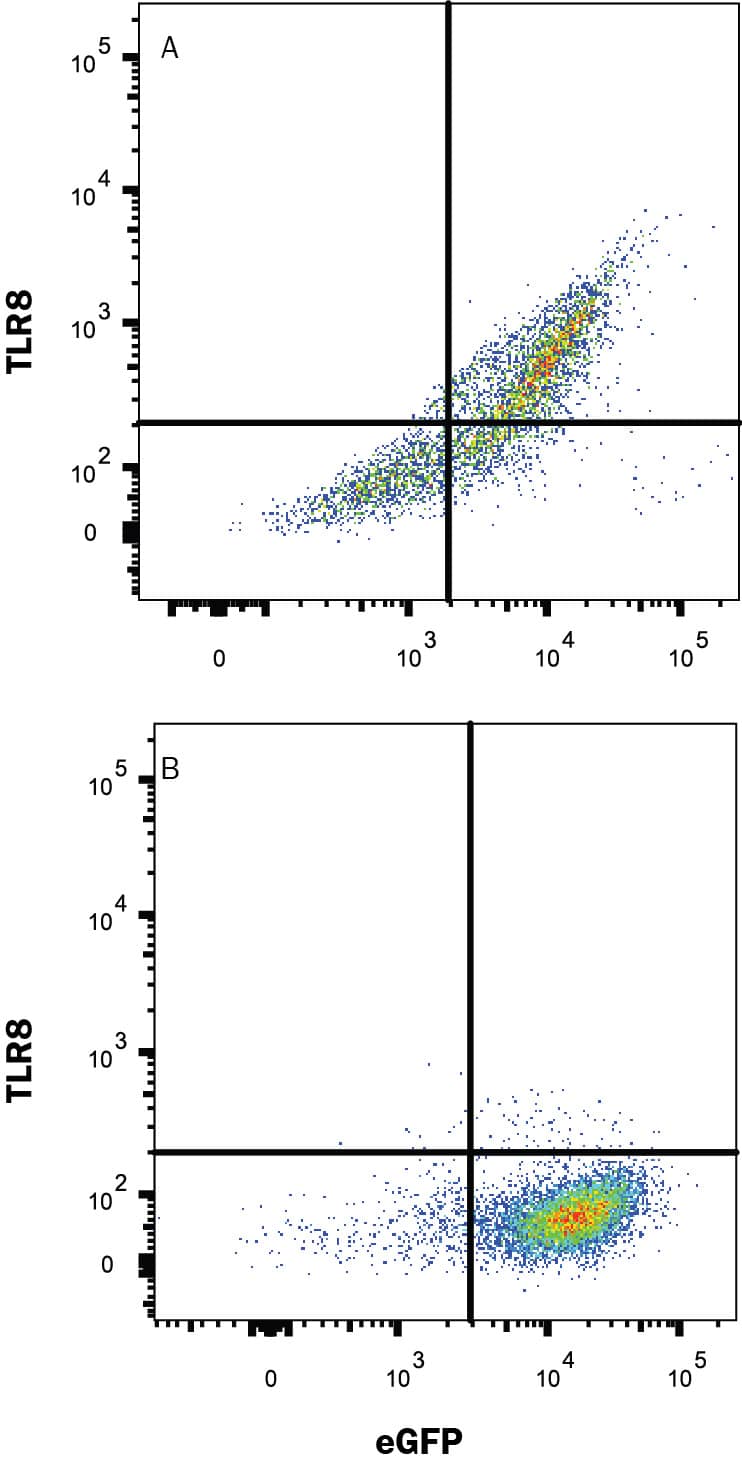TLR8 Products
TLRs make up a family of pattern recognition receptors that play important roles in the innate immune response. Broad classes of pathogens (e.g. viruses, bacteria, and fungi) constitutively express a set of mutation-resistant molecules called pathogen-associated molecular patterns (PAMPs). These microbial molecular markers may be composed of proteins, carbohydrates, lipids, nucleic acids and/or combinations thereof. Individual TLRs recognize distinct pathogen-associated PAMPs, initiating signaling cascades that promote the immune response. Structurally, TLRs are type I transmembrane receptors that possess varying numbers of extracellular N-terminal leucine-rich repeat (LRR) motifs, followed by a cysteine-rich region, a TM domain, and an intracellular Toll/IL-1 R (TIR) motif. The TIR motif is common to the larger IL-1 R/TLR superfamily.
117 results for "TLR8" in Products
117 results for "TLR8" in Products
TLR8 Products
TLRs make up a family of pattern recognition receptors that play important roles in the innate immune response. Broad classes of pathogens (e.g. viruses, bacteria, and fungi) constitutively express a set of mutation-resistant molecules called pathogen-associated molecular patterns (PAMPs). These microbial molecular markers may be composed of proteins, carbohydrates, lipids, nucleic acids and/or combinations thereof. Individual TLRs recognize distinct pathogen-associated PAMPs, initiating signaling cascades that promote the immune response. Structurally, TLRs are type I transmembrane receptors that possess varying numbers of extracellular N-terminal leucine-rich repeat (LRR) motifs, followed by a cysteine-rich region, a TM domain, and an intracellular Toll/IL-1 R (TIR) motif. The TIR motif is common to the larger IL-1 R/TLR superfamily.
Clone 44C143 was used by HLDA to establish CD designation.
| Reactivity: | Human, Mouse, Rabbit |
| Details: | Mouse IgG1 kappa Monoclonal Clone #44C143 |
| Applications: | IHC, WB, ICC/IF, Flow, CyTOF-ready, +2 More |
| Reactivity: | Human |
| Details: | Mouse IgG2A Monoclonal Clone #303F1.14 |
| Applications: | IHC, WB, ICC/IF, Flow |
| Reactivity: | Human |
| Details: | Mouse IgG2b Monoclonal Clone #935166 |
| Applications: | Flow, CyTOF-ready |
| Reactivity: | Human |
| Details: | Mouse IgG2b Monoclonal Clone #935166 |
| Applications: | ICFlow |
| Reactivity: | Human |
| Details: | Mouse IgG2b Monoclonal Clone #935166 |
| Applications: | ICFlow |
| Reactivity: | Human |
| Details: | Mouse IgG2b Monoclonal Clone #935166 |
| Applications: | ICFlow |
| Reactivity: | Human |
| Details: | Mouse IgG2b Monoclonal Clone #935166 |
| Applications: | ICFlow |
| Reactivity: | Human |
| Details: | Mouse IgG2b Monoclonal Clone #935166 |
| Applications: | ICFlow |
| Reactivity: | Human |
| Details: | Mouse IgG2b Monoclonal Clone #935166 |
| Applications: | ICFlow |
| Reactivity: | Human |
| Details: | Mouse IgG2b Monoclonal Clone #935166 |
| Applications: | ICFlow |
| Reactivity: | Human, Mouse |
| Details: | Rabbit IgG Polyclonal |
| Applications: | WB, ICC/IF, ELISA |
| Reactivity: | Human |
| Details: | Mouse IgG2b Kappa Monoclonal Clone #4C6 |
| Applications: | WB, ELISA |
| Reactivity: | Human |
| Details: | Rabbit IgG Polyclonal |
| Applications: | IHC |
| Reactivity: | Human |
| Details: | Mouse IgG2a Kappa Monoclonal Clone #D2 |
| Applications: | WB, ICC/IF |
| Applications: | AC |
| Applications: | AP |
| Applications: | WB |
| Reactivity: | Human |
| Details: | Mouse IgG2a Kappa Monoclonal Clone #D4 |
| Applications: | WB |
| Applications: | ELISA |
| Applications: | ELISA |
| Reactivity: | Human, Mouse |
| Details: | Rabbit IgG Polyclonal |
| Applications: | WB, ELISA, ICC/IF |
| Reactivity: | Human, Mouse |
| Details: | Rabbit IgG Polyclonal |
| Applications: | WB, ICC/IF, ELISA |
| Reactivity: | Human, Mouse |
| Details: | Rabbit IgG Polyclonal |
| Applications: | WB, ELISA, ICC/IF |

![Flow Cytometry: TLR8 Antibody (44C143) - BSA Free [NBP2-24917] Flow Cytometry: TLR8 Antibody (44C143) - BSA Free [NBP2-24917]](https://resources.bio-techne.com/images/products/TLR8-Antibody-44C143-Flow-Cytometry-NBP2-24917-img0018.jpg)
![Immunohistochemistry-Frozen: TLR8 Antibody (303F1.14) [DDX0480P-100] Immunohistochemistry-Frozen: TLR8 Antibody (303F1.14) [DDX0480P-100]](https://resources.bio-techne.com/images/products/TLR8-Antibody-303F1-14-Immunohistochemistry-Frozen-DDX0480P-100-img0007.jpg)




![Western Blot: TLR8 AntibodyBSA Free [NBP1-77203] Western Blot: TLR8 AntibodyBSA Free [NBP1-77203]](https://resources.bio-techne.com/images/products/TLR8-Antibody-Western-Blot-NBP1-77203-img0001.jpg)
![Western Blot: TLR8 Antibody (4C6) [H00051311-M01] Western Blot: TLR8 Antibody (4C6) [H00051311-M01]](https://resources.bio-techne.com/images/products/TLR8-Antibody-4C6-Western-Blot-H00051311-M01-img0004.jpg)
![Immunohistochemistry-Paraffin: TLR8 Antibody [NBP1-85767] Immunohistochemistry-Paraffin: TLR8 Antibody [NBP1-85767]](https://resources.bio-techne.com/images/products/TLR8-Antibody-Immunohistochemistry-Paraffin-NBP1-85767-img0007.jpg)
![Western Blot: TLR8 Antibody (D2) [NBP3-41476] - TLR8 Antibody (D2)](https://resources.bio-techne.com/images/products/nbp3-41476_mouse-tlr8-mab-d2-612202421373042.jpg)
![Western Blot: TLR8 Overexpression Lysate [NBP2-05618] Western Blot: TLR8 Overexpression Lysate [NBP2-05618]](https://resources.bio-techne.com/images/products/TLR8-Overexpression-Lysate-Adult-Normal-Western-Blot-NBP2-05618-img0001.jpg)

![ELISA: Human TLR8 - Ready-To-Use ELISA Kit (Colorimetric) [NBP3-40253] Human TLR8 - Ready-To-Use ELISA Kit (Colorimetric)](https://resources.bio-techne.com/images/products/nbp3-40253_human-tlr8-ready-to-use-elisa-kit-colorimetric-211020241528238.png)
![ELISA: Human TLR8 ELISA Kit (Colorimetric) [NBP3-40270] Human TLR8 ELISA Kit (Colorimetric)](https://resources.bio-techne.com/images/products/nbp3-40270_human-tlr8-elisa-kit-colorimetric-2110202415371385.png)